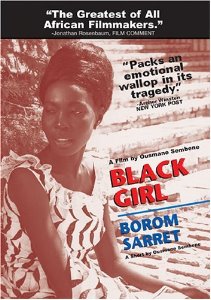- Black Girl (film)
Infobox Film
name = La Noire de...

caption = DVD Cover
director =Ousmane Sembène
writer =Ousmane Sembène
starring =Mbissine Thérèse Diop ,Anne-Marie Jelinek andRobert Fontaine
producer =André Zwoboda
cinematography =Christian Lacoste
editing=André Gaudier
distributor = New Yorker Video
released =
country = FRA / SEN
runtime = 65 min
language = French
imdb_id = 0060758"La Noire de...", also known as "Black Girl" (The original French title is literally translated as "The Black Girl of..." ) is a 1966 film directed by
Ousmane Sembène . The film is often considered the firstSub-Saharan Africa n film by an African filmmaker to receive international attention. [Weiler, A. H. "2 From Senegal:Feature and Short Are at the New Yorker" "New York Times ", January 13, 1969 [http://movies2.nytimes.com/mem/movies/review.html?title1=Noire%20de%2e%2e%2e%2c%20La%20%28Movie%29&title2=&reviewer=A%2e%20H%2e%20WEILER&pdate=19690113&v_id=139095] ]The film is based on Sembène's own writing. Though he previously directed two shorts: "
Borom Sarret " and "Niaye ", "Black Girl" was his first feature-length film. [cite book
first =Geoffrey
last =Nowell-Smith
year = 1996
title = The Oxford History of World Cinema
chapter =
editor =
others =
edition =
pages =
publisher =
location =
id = ISBN 0-19-874242-8] In "Movies as Politics", Jonathan Rosenbaum makes a case for Senegal writer-director Ousmane Sembene's "La Noire de..." as the symbolic genesis of sub-Saharan African filmmaking, at least to the extent that the authorship belonged to a born and bred African. [cite book
first =Jonathan
last =Rosenbaum
year = 1997
title = Movies as Politics
chapter =
editor =
others =
edition =
pages = 284
publisher = University of California Press
location = Berkeley, Calif
id = ISBN 0520206150]Plot
The film centers on Diouana (Mbissine Thérèse Diop), a young Senegalese woman who moves from
Dakar, Senegal , toAntibes ,France , to work for a rich French couple (Anne-Marie Jelinek and Robert Fontaine). In France, Diouana hopes to continue her former job as nanny, and looks forward to a cosmopolitan lifestyle. However, upon arrival in Antibes, the couple begins to treat Diouana more harshly and she is forced to work in the capacity of a servant. Diouana becomes increasingly aware of her constrained and alienated situation.Themes
This film addresses the effects of
colonialism ,racism and post-colonial identity in Africa and Europe. These themes are highlighted through the recurring appearance of an African mask, which is given to her employers by Diouana on her first day of work at the house in Dakar. The mask is hung on the wall in the French couple's Senegalese apartment, along with other pieces ofAfrican art . The mask also travels with Diouana to France, where it hangs alone on the wall.Awards
* 1966,
Prix Jean Vigo for best feature filmReferences
External links
*imdb title|0060758
*fr icon [http://www.ousmanesembene.com/lanoirde.htm At ousmanesembene.com]
* [http://www.sensesofcinema.com/contents/cteq/02/23/black_girl.html Introduction at Senses of Cinema]
* [http://www.slantmagazine.com/dvd/dvd_review.asp?ID=831 Slant Magazine review]
* [http://movies2.nytimes.com/mem/movies/review.html?title1=Noire%20de%2e%2e%2e%2c%20La%20%28Movie%29&title2=&reviewer=A%2e%20H%2e%20WEILER&pdate=19690113&v_id=139095 New York Times Review]
Wikimedia Foundation. 2010.
